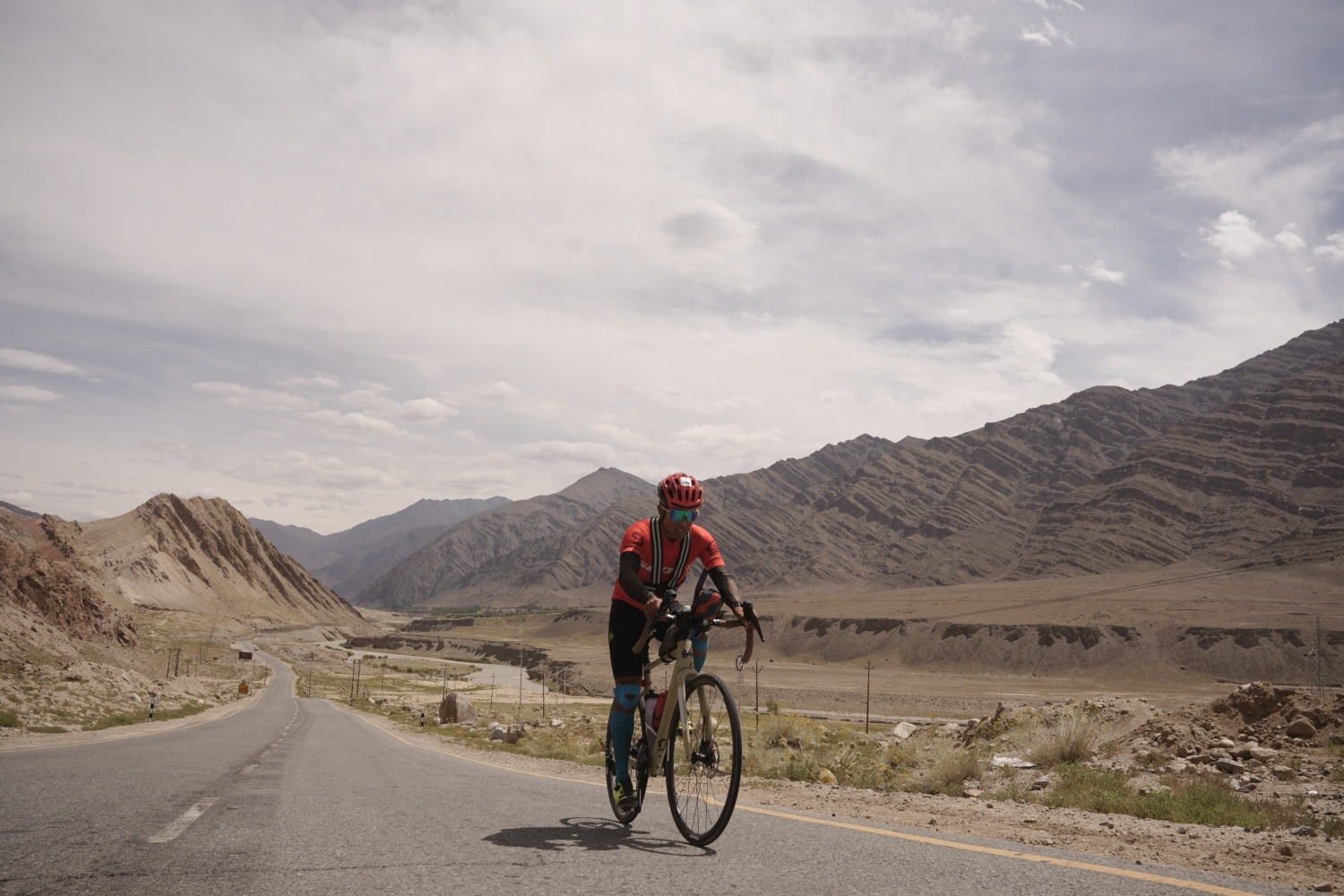We are in conversation with Faisal Qadir after his Himalayan Ultra Cycling win. He’s possibly the only person to have completed ultra bicycle rides and ultra runs in the lofty environ of Ladakh. He tells us about winning in cycling, the Ladakhi cycling and running culture and how he used AI to create his training plan!
In the high mountains, where the air is thinner than road bike tyres, a 26-year-old from Leh, etched his castles in the air; by being the first to have ridden and run ultra events in Ladakh. Faisal Qadir, a young man with bubbling energy and a beaming smile forever plastered on his face is the quintessential mountain goat. Inspired by his dad and brother to get into sports from a young age, he has been running and cycling in places, where we flatlanders struggle to even walk 10 steps without running out of breath. An environmental consultant by profession, he has always been driven by a desire to push his physical limits. His journey, however, is far from conventional.
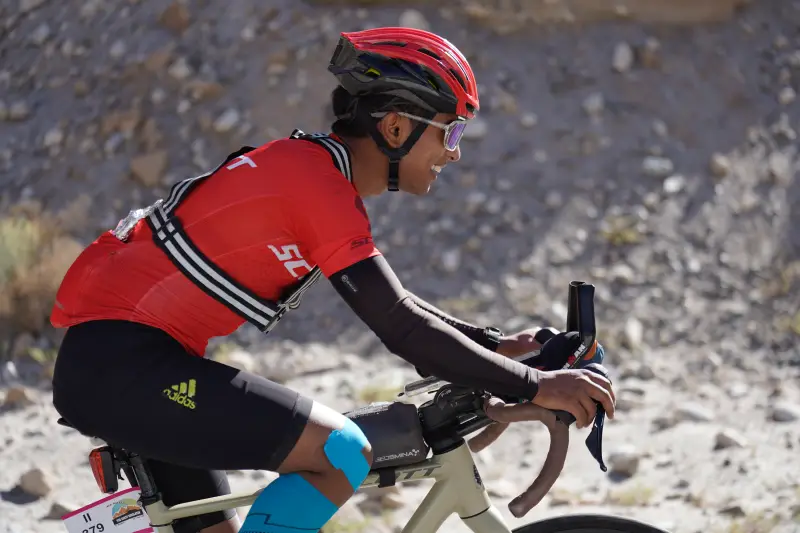
Faisal Qadir’s Himalayan Ultra Cycling Experience
The Great Himalayan Ultra is an annual ultra-distance cycling event conducted by Inspire India in Ladakh. This was the first edition in which a local resident participated.
BOTS Training Quads!
Faisal’s training for the Himalayan Ultra was an experiment in modern athletic preparation. Possibly taking a leaf out of one of those mad scientists from a Marvel flick. He decided to experiment on his quads and well the rest of his body too!
He built his training regimen using a generative AI chatbot, Gemini, a tool he was familiar with from his professional life. This wasn’t his first time using AI for training. A previous attempt for an ultramarathon was a learning experience, but this time, he was all-in. “I thought, why not go with an AI chatbot for that, right? Because I did my own research and got an understanding of how training works. I realized that instead of just me relying on my capacity to gain and implement knowledge, I can just tap into this tool which uses knowledge from the known human database,” Faisal explained.
He approached the AI tool with a structured, methodical prompt. First, he fed Gemini details about the specific race and the kind of training knowledge he wanted it to reference. This allowed the chatbot to create a new, adaptive training plan each week based on his actual performance.
Real vs. Artificial
While the AI chatbot was highly adaptable, adjusting the plan based on his weekly performance or any unplanned rides, it was not without its flaws. Faisal noted its “limited memory“. Which sometimes led to hallucinations. Such as incorrect dates for the race, or putting him into a tapering phase too early. Despite these drawbacks, he rated his experience a seven out of ten. Acknowledging the tool’s accessibility and its ability to provide a “good enough” training plan. The experience underscored the need for human oversight, a lesson he would later apply to his final race preparations.
Faisal stressed the fact that one cannot use AI blindly, he learnt that the hard way. It needs human oversight and a decent level of knowledge of AI and cycling by the user. The chatbot sure didn’t help him become the hulk. Though it did help in being a virtual coach to ensure his training was consistent and flexible to change.
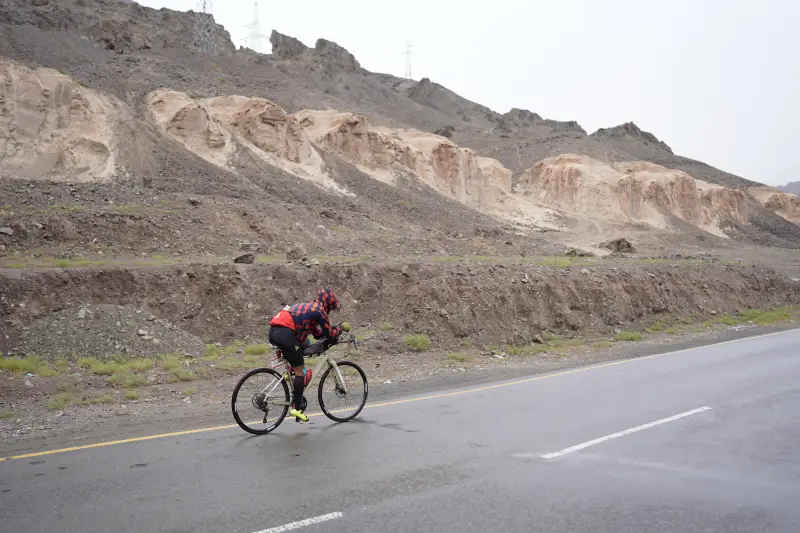
The Machines are Taking Over… Schwarzenegger(s) to the Rescue
While the AI bot provided the foundational training plan, Faisal’s ultimate success was cemented by the guidance of ultra cycling veterans and experts, Kabir Rachure and Sumit Patil. Just a few weeks before the race, they sat down with him to review his AI-generated plan. Their feedback was critical: the training volume was not optimal for the race’s demands. This was a crucial “reality check” for Faisal, who, until then, believed he was on a good track.
The duo’s contribution extended far beyond mere feedback. They transformed his entire approach, offering a level of support that was both practical and psychological. They helped him refine his race setup, a process that Sumit painstakingly managed over three weeks, incrementally shedding weight from his bike. His original plan to carry multiple bags and a hydration pack was scrapped in favour of a lean setup with just a single top-tube bag. Sumit even lent him his road tyres and performed a bike fit, optimizing his aero bars to be the most comfortable riding position. This proved to be a significant advantage, especially on the flat stretches of the first day.
Psychological > Physiological
However, their most profound impact was psychological. Faisal, a local, felt the pressure to perform well, with his personal goal being a podium finish. But Kabir and Sumit had a higher expectation. “They were confident that I would win. And to ensure that, throughout the last two weeks before the race, they regularly told me that I have to win. I have to win.” This constant pressure, a “huge driver,” resonated in his head throughout the race, propelling him to push beyond his own expectations. The final weeks of training, guided by Sumit and Kabir, included a critical simulation ride of the Leh-Kargil route. This ride, more than anything, boosted his confidence, as he realized he could handle the distance with a surprisingly low level of effort, riding comfortably in zone two.
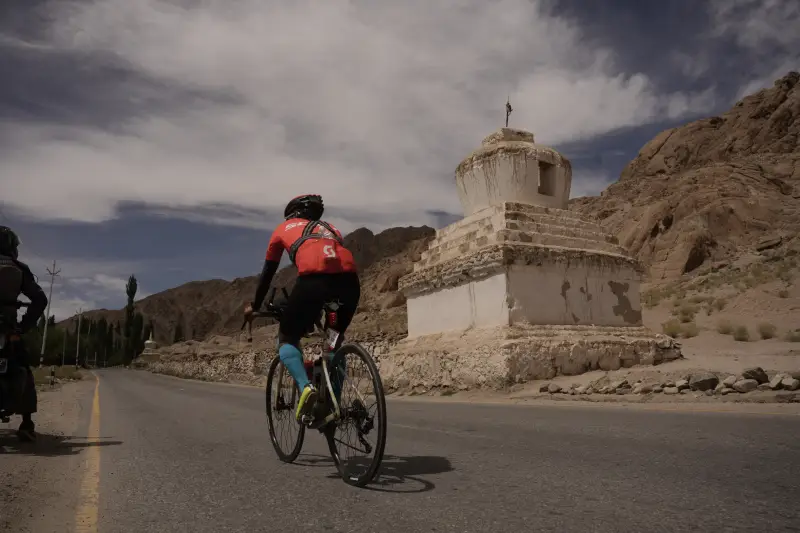
Vocal for Local?
Faisal believes being a local in a race like the Himalayan Ultra provides a significant advantage. This advantage isn’t just about the physical acclimatization to the high altitude, which is a key factor, but also a deeper, more nuanced understanding of the environment. “It’s very easy and economical for me to go and understand the route in the first place,” he explained.
His local knowledge extended to practical aspects of the race. Knowing where to find aid stations, where to get water or food, and how the unpredictable weather patterns of Ladakh could affect the race. For instance, on the first day, the weather was unusually hot. While this posed a challenge for many competitors, Faisal, who had been training in similar conditions for months, was able to handle it much better. He noted that his primary competitor, Nikhil, seemed to suffer from the heat, which potentially cost him his lead.
The support system he had, being a local, was also unparalleled. His father met him at the finish line, took his bike, and drove him back, allowing him to immediately begin his recovery protocol with a protein shake and a massage. A luxury most out-of-towners couldn’t afford. The familiarity of his surroundings, even while staying in a hotel, offered a sense of comfort that contributed to his rest and recovery.
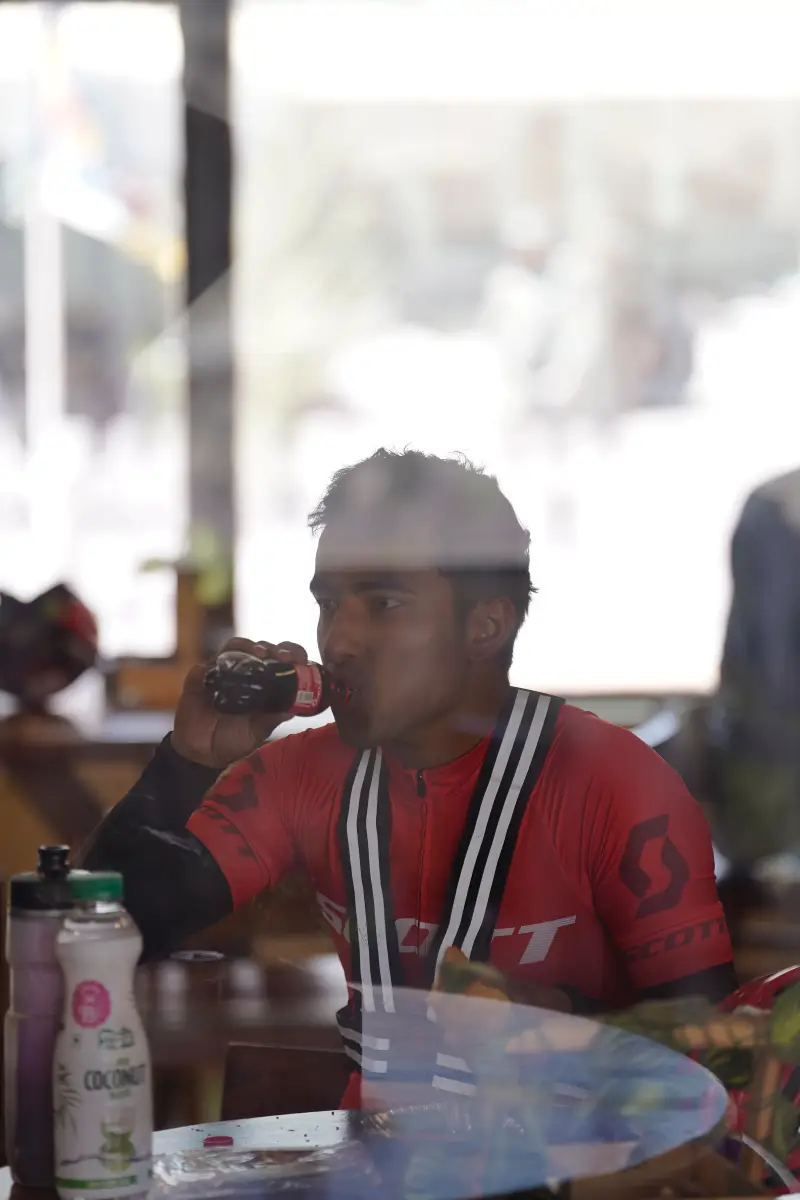
Competitive Much?
However, being a local also came with a disadvantage: a lack of competitive spirit. Faisal observed that the out-of-town racers started strong, working together and drafting to establish an early lead. In contrast, he was “just doing my own race, just not thinking too hard about ‘Oh, I need to win, I need to win.’” This mindset, while eventually overcome by the psychological pressure from his friends, was a stark contrast to the competitive hunger of his rivals. Another disadvantage was the race’s terrain on the first day, which was primarily rolling hills and flats—conditions less common in Ladakh and thus not a strength for him.
Possibly one of the biggest arrows in Faisal’s quiver was neutralized by the fact that the race didn’t cross any of the famed Ladakhi passes. The higher the altitude the bigger would’ve been his advantage.
Judgement Day(s)
Day 1
The race began at 6:00 a.m. in Leh with a descent out of the city. Faisal being a lightweight rider, expected others to pull away. “I was very confident that I would close the gap on the climbs,” he recalls, “but that was a huge overestimation of my capabilities.” The competitors gained a significant lead on the flats. However, his strategy to catch up on the climbs worked eventually. By the time they reached the Chushul climb, he had overtaken two riders, Delton and Yogesh, boosting his confidence. The rolling hills that followed were challenging, but Faisal was holding his own, riding comfortably in zone 3.
The true test came 6 km before Kiari. He saw his main competitor, Nikhil, already on his way back, a full hour ahead of him. This “huge reality check” was a wake-up call. “Being local doesn’t make you invincible. You actually have to put in the work and be very focused.”
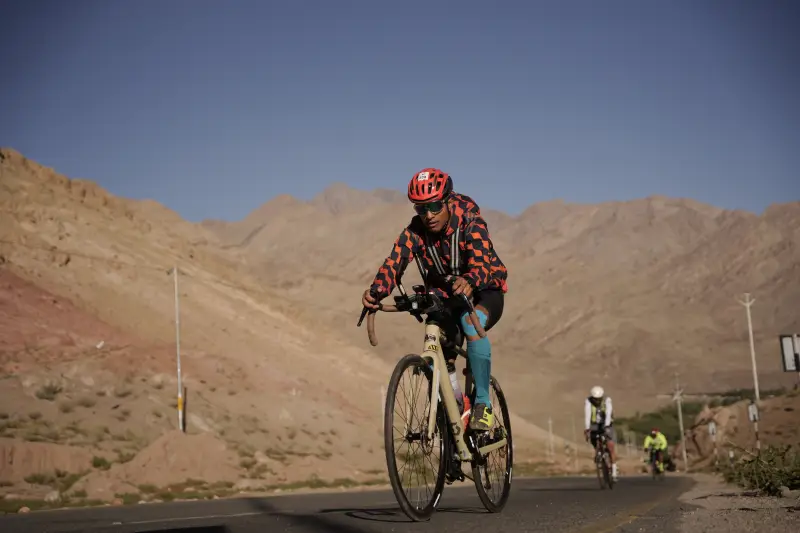
Putting in the Effort
After a 15-minute stop in Kiari, he launched his counter-attack, riding “like a missile” towards Upshi. When he learned that Nikhil was only at Karu (a hop, skip and jump away); a huge surge of motivation pushed him to climb “harder than I should have.” He remembered his friends’ advice: to go full gas after Karu, and he did just that. He rode glued to his aero bars, ignoring the pain in his lower back. When he finally saw Nikhil on the final climb, he put on a brave face and greetied him casually. He saw that Nikhil was struggling, parched and exhausted. To the point where he had to get off his bike and lay flat on the footpath.
Knowledge of the landscapes and the many dangers that they posed, including hearing of fatalities every tourist season increased Faisal’s concern for his competitor’s well-being. In a testament to his character; he went back to give Nikhil a bottle of water, before continuing, to win the stage with a mere two-minute gap.
Day 2
The grand strategy on the second day of racing was to “chill“! At the very least on the first climb.
Faisal’s plan was to conserve energy for the critical climbs later in the day. On the Basgo climb, he intentionally let his competitors go ahead slightly, wanting them to feel a false sense of security before he launched his attack. “I dropped an attack and just flew past both of them,” he says, creating a psychological gap he was determined to maintain. The second day was characterized by rain and cold. With temperatures dropping to single digits, a sharp contrast to the previous day’s heat. Despite his legs “arguing” with him on the final climbs, he pushed through. Fuelled by the proximity of the finish line and the presence of his father and brother. He finished with a commanding one-hour lead over the second-place finisher, a testament to his strategic prowess and relentless determination.
His victory may or may not be attributed to a stolen roti! Somewhere near the midpoint of the race on the second day, Faisal stopped to refuel. The parathas he ordered at the dhaba were taking well over 15-minutes to prepare. So he dove into the bread basket of fellow diners. Whisked away a roti with due permission before charging out, clutching said roti and a few bananas. Saving himself a mammoth 10-minutes. Even strangers play a role when you are racing ultra-endurance events!
Ultra This… Ultra That…
Having done both ultra running and ultra cycling in Ladakh, Faisal offers a unique perspective on the two endurance sports. His first observation is a simple one: cycling is “so much easier.” He explains that after a 72 km ultra-run that took him 13 hours, he was “off for a few days,” to the point of needing help to cross the road. After his 20-hour, two-day ultra cycling race, he was able to walk the next morning and show up to a meeting as if nothing had happened.
He also believes that altitude affects cyclists less. While runners spend a long time at high altitudes, cyclists can rapidly descend, minimizing their exposure. From a nutrition standpoint, Faisal found that he consumed far less energy gels during his cycling race. He attributes this to the ability to carry more solid food on the bike. Which is more satiating and provides a slow release of energy, unlike the gels that are a staple for runners. He relied on homemade energy bars and bananas, which he could not have consumed as easily during a running race.
While he was able to maintain high-intensity heart rate zones during his cycling race, a feat that would have been more difficult for him in a run of a similar duration, he acknowledges that the demands of each sport are different. “I was happy to see that I can maintain that [high intensity] over the course of this long distance,” he said, noting that the intensity of the race pushed him to a new level.
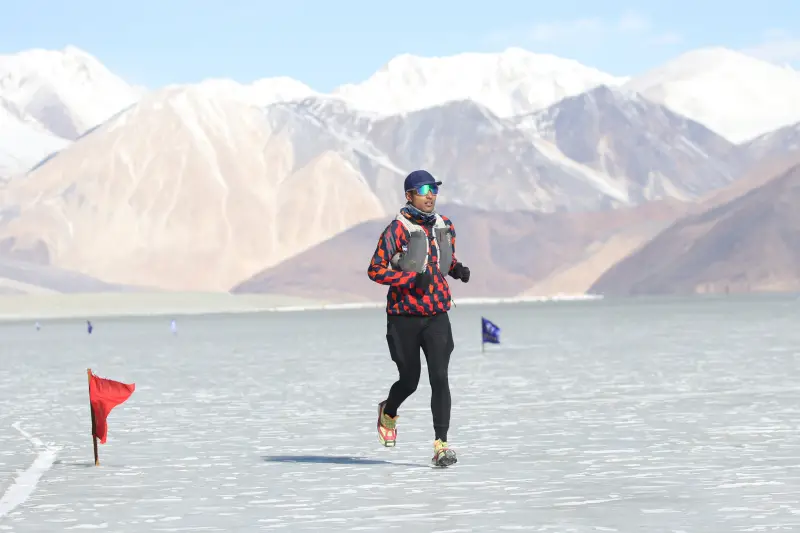
Comparing Communities and Cultures of ‘Ultra’ Ladakh
Faisal draws a clear distinction between the local running and cycling communities in Ladakh. The running community, he says, is “much more vibrant.” He attributes this to the Ladakh Marathon. An event that has been instrumental in building a strong local running culture over the last decade. The accessibility of the sport, which only requires a pair of shoes, has also contributed to its growth. Producing elite athletes who compete at a national and international level.
The local cycling community, in contrast, is “pretty small,” especially for long-distance enthusiasts. He believes the financial barrier of acquiring a decent bike is a major factor. While he sees many tourists, “every other day you will find one cyclist on the road“, cycle touring from Leh to Manali or Srinagar; this has not translated into a vibrant local community. Tourists are yet to inspire locals to the same degree. Having said that, there are a bunch of young Ladakhi athletes making waves in the MTB circuits of the country.
Despite this, Faisal sees a strong potential for cycling to grow, particularly with external initiatives. He hopes that the presence of high-level cyclists and the popularity of taking Strava KOMs on local climbs will inspire more Ladakhis to take up the sport. The current lack of events, often due to politicking, is a major hurdle. Faisal’s ultimate hope is for Ladakh to become a “brighter spot on the cycling world map,” with its iconic climbs attracting riders from around the globe, and inspiring a new generation of local athletes.
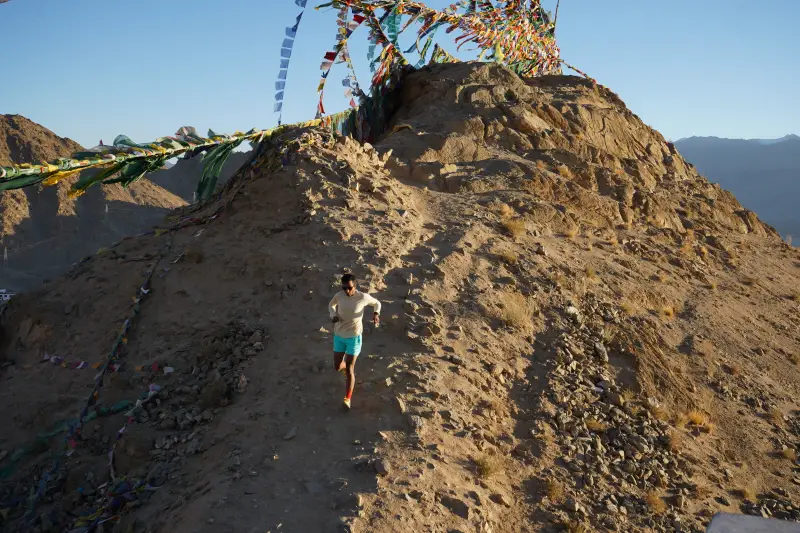
Making Molehills out of Mountains…
‘Just’ winning bicycle races and completing ultra marathons isn’t challenging enough for Faisal. The real challenge which he hopes to crest, is reviving the local cycling community.
And with that mountain in sight, we wish Faisal loads of luck in getting people back on the saddle…
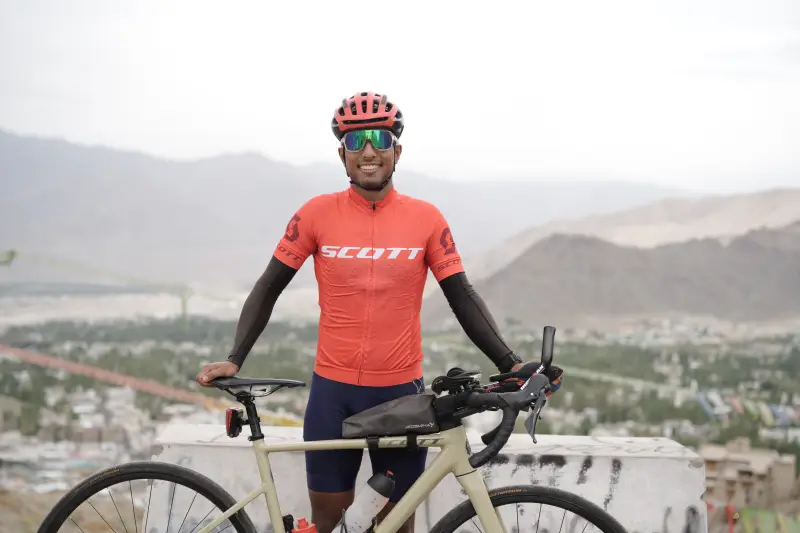
You can follow Faisal Qadir on Instagram and Strava.
Photos Courtesy: Inspire India and Athlos

Also read, Faisal’s Epic Everesting Ride in Ladakh and the Ladakh Winter Gran Fondo…

